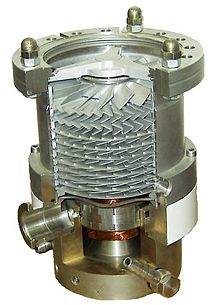Turbo molecular pump
A turbo molecular pump is a mechanical vacuum pump . It works by pumping the gas in a molecular flow promotes, that works like that of Wolfgang Gaede invented in 1913 molecular pump . It is made up of circular turbine and stator disks, which follow one another alternately and are attached to a rotor axis or in the pump housing. The electric drive motor is located on the rotor axis. It is named after the turbine-like rotation of its moving parts. It was invented by Willi Becker in 1956.
construction
A turbo molecular pump contains a rotor that carries the turbine disks and the rotor of the electric drive motor . The turbine disks are made up of flat blades running in a star shape, which are tilted against the plane of the disk like fan blades. Correspondingly structured stator disks, the blades of which are tilted in the opposite direction, lie between the disk blades. The stator disks are firmly connected to the internally cylindrical housing. In order to dissipate the operating heat from the pump, water cooling is often installed in the pump housing.
A distinction is made between double-flow and single-flow turbo molecular pumps. In the double-flow arrangement, both ends of the axle are on the fore-vacuum side, and the rotor and stator disk packs are mirror-symmetrically on and around the axle. The vacuum flange , the connection to the recipient, is located in the space between the two packages . The drive motor is on the fore-vacuum side of a disk pack. The advantage of this arrangement is that both bearings are on the fore-vacuum side. In this way, contamination of the vacuum chamber with lubricant can be avoided even if two lubricated bearings are used.
Single-flow turbomolecular pumps only have one disk pack and their axis of rotation is vertical, they deliver from top to bottom. At the bottom of the fore-vacuum side they run in a lubricated bearing, the upper axle bearing on the recipient side is designed as a non-contact permanent magnet bearing . To increase the fore-vacuum pressure, single-flow turbomolecular pumps are often combined with one or more molecular pump stages, which are usually designed as Holweck , so-called drag stages.
Mode of action
Like other molecular pumps, a turbo molecular pump creates a molecular flow. To achieve this, two conditions must be met:
- Your rotor blades must move at least at the mean speed of the gas particles to be conveyed so that they can transmit an impulse to them, and
- the free path of the gas particles must be in the order of magnitude of the dimensions of the active parts so that the molecular flow does not come to a standstill.
Therefore, the rotors of turbo molecular pumps reach very high speeds, which are in the order of tens of thousands of revolutions per minute.
If a gas particle hits a turbine blade, the impact accelerates it in the pumping and rotating directions. The blades of the next stator disk guide it on in the pumping direction, whereby it comes into the area of the next turbine disk. Due to the fact that the pump works with a molecular flow and the minimum dimensions that the turbine disks must have structurally, a pure turbo-molecular pump can only work up to fore-vacuum pressures in the range of a few 10 Pa and requires a correspondingly good fore-vacuum. By combining it with one or more molecular pumping stages, the fore-vacuum pressure can be increased to around 1500 Pa.
Pumping power
A turbo-molecular pump reached, depending on the gas load, and if a baking is performed, final pressures of up to . Since gas particles with a low molar mass have a higher mean speed of their thermal movement, the turbo molecular pump can only change their momentum less than that of gas particles with a high molar mass. Because of this, their decompression capacity for substances with a low molar mass such as hydrogen and helium is smaller than for those with a high molar mass.
Web links
Brief technical description of turbo molecular pumps and drag stages
literature
- Karl Jousten (Hrsg.): Wutz manual vacuum technology . 10th edition. Vieweg + Teubner, Wiesbaden 2010, ISBN 978-3-8348-0695-6 , pp. 378-413 .
Individual evidence
- ^ Wutz: Handbook Vacuum Technology. Vieweg + Teubner 2010, pp. 394, 395.

